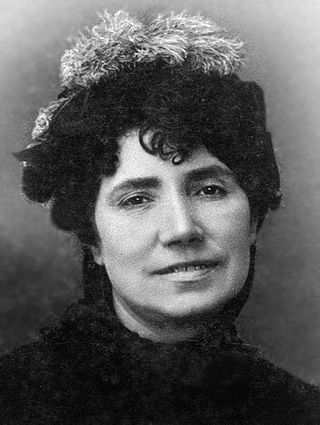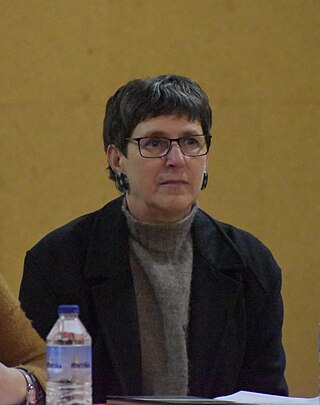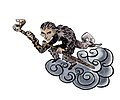
Galicia is an autonomous community of Spain and historic nationality under Spanish law. Located in the northwest Iberian Peninsula, it includes the provinces of A Coruña, Lugo, Ourense, and Pontevedra.

María Rosalía Rita de Castro, was a Galician poet and novelist, considered one of the most important figures of the 19th-century Spanish literature and modern lyricism. Widely regarded as the greatest Galician cultural icon, she was a leading figure in the emergence of the literary Galician language. Through her work, she projected multiple emotions, including the yearning for the celebration of Galician identity and culture, and female empowerment. She is credited with challenging the traditional female writer archetype.

Vigo is a city and municipality in the province of Pontevedra, within the autonomous community of Galicia, Spain. Located in the northwest of the Iberian Peninsula, it sits on the southern shore of an inlet of the Atlantic Ocean, the Ria de Vigo, the southernmost of the Rías Baixas. It is the capital of the comarca of Vigo.
Lusitanian mythology is the mythology of the Lusitanians, an Indo-European speaking people of western Iberia, in what was then known as Lusitania. In present times, the territory comprises the central part of Portugal and small parts of Extremadura and Salamanca.

Galician–Portuguese, also known as Galaic–Portuguese, Old Galician–Portuguese, Old Galician or Old Portuguese, Medieval Galician or Medieval Portuguese when referring to the history of each modern language, was a West Iberian Romance language spoken in the Middle Ages, in the northwest area of the Iberian Peninsula. Alternatively, it can be considered a historical period of the Galician, Fala, and Portuguese languages.

The Coco or Coca is a mythical ghost-like monster, equivalent to the bogeyman, found in Spain and Portugal. Those beliefs have also spread in many Hispanophone and Lusophone countries. It can also be considered an Iberian version of a bugbear as it is a commonly used figure of speech representing an irrational or exaggerated fear. The Cucuy is a male being while Cuca is a female version of the mythical monster. The "monster" will come to the house of disobedient children at night and take them away.

The mythology of the ancient Basques largely did not survive the arrival of Christianity in the Basque Country between the 4th and 12th century AD. Most of what is known about elements of this original belief system is based on the analysis of legends, the study of place names and scant historical references to pagan rituals practised by the Basques.

The Minho or Miño is the longest river in the autonomous community of Galicia in Spain, with a length of 340 kilometres (210 mi). It forms a part of the international border between Spain and Portugal. By discharge volume, it is the fourth largest river of the Iberian Peninsula after the Douro, Ebro, and Tagus rivers.

Galicians are a Romance-speaking European ethnic group from northwestern Spain; they are closely related to the northern Portuguese people and have their historic homeland in Galicia, in the north-west of the Iberian Peninsula. Two Romance languages are widely spoken and official in Galicia: the native Galician and Spanish.
The Enchanted moura or moura encantada is a supernatural being from the fairy tales of Portuguese and Galician folklore. Very beautiful and seductive, she lives under an imposed occult spell. Shapeshifters, the mouras encantadas occupy liminal spaces and are builders with stone of formidable strength.
The Nuberu, Ñuberu, Reñubeiru or Nubeiru, Nubero (Castilian) or Nubeiro (Galician) -literally "The Clouder"- is a character of Asturian, Cantabrian, Galician and Leonese mythology. According to Asturian mythology, the Nuberu, is the divinity of clouds and storms.
According to Portuguese, Galician, and Asturian mythology, the Mouros or Moiros are a race of supernatural beings which inhabited the lands of Galicia, Asturias and Portugal since the beginning of time.

Cantabrian mythology refers to the myths, teachings and legends of the Cantabri, a pre-Roman Celtic people of the north coastal region of Iberia (Spain). Over time, Cantabrian mythology was likely diluted by Celtic mythology and Roman mythology with some original meanings lost. Later, the ascendancy of Christendom absorbed or ended the pagan rites of Cantabrian, Celtic and Roman mythology leading to a syncretism. Some relics of Cantabrian mythology remain.

The culture of Galicia is the patterns of human activity and symbolism associated with the Galicia region of Spain and the Galician people.

Mount Pindo is a mountain located in the autonomous community of Galicia, Spain. It is in the municipality of Carnota and province of A Coruna. Composed of granite, it has a height of 627m. It is of local mythological importance.
The history of the Galician language can be summarized as seven centuries of normality and five centuries of conflict. From its origins when it separated from the Galician Latin in the 9th century until the introduction of Castilian in the 16th century there was peace, and from the 16th century until the present there were various conflicts.

The Spanish legend of la Encantada is a generic name that refers to a set of oral traditions and legends mythological narrated in numerous Spanish localities. Although there are multiple local variants, a series of elements are common: the protagonist, the time, the manifestation and other elements.

Queen Lupa is a character from Galician mythology. She is mentioned in both the Codex Calixtinus and the Golden Legend involving the translation of the body of the Apostle James by his disciples. Her name alludes to her cunning, and she is written as being a roadblock to the disciples of the Apostle James, Theodore and Athanasius, as they search for a place to entomb his body. She eventually sees her error and converts to Christianity.

Manuel Gago Mariño is a Galician journalist and scholar.

Ana Isabel Boullón Agrelo is a Galician linguist. Since 2012, she has been a corresponding member of the Royal Galician Academy (RAG) and in the session of 22 December 2020, she was elected an academic numerary. She read her induction speech at A Pobra do Caramiñal on 11 November 2021, answered by Ramón Lorenzo.



























